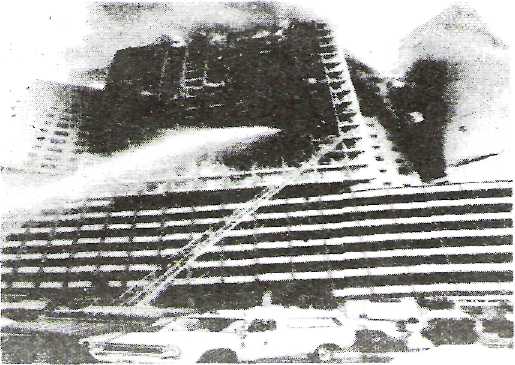
- •Introduction
- •The vulcano vesuvies Chapter 1. Part I
- •Part II
- •The great fire of london Chapter 2. Part I
- •Part II
- •Part III
- •The titanic Chapter 3. Part I
- •Part II
- •Part III
- •Part IV
- •Floods and storms Chapter 4.
- •Part II
- •Part III
- •Part IV
- •Fire in brazil Chapter 5.
- •Bhopal, india Chapter 6. Part I
- •Part II
- •Chernobyl Chapter 7. Past I
- •Part II
- •The challenger disast Chapter 8. Part I
- •Part II
- •The exxon valdez Chapter 9. Part I
- •Part II
- •The kobe earthquake Chapter 10.
- •Conclusion Chapter 11.
Part IV
Although a tornado is an uncontrollable force of nature, its power is surprisingly exact. The great power is all held in the 'eye' or the centre of the tornado.
A man aged sixty-three in the state of Georgia pushed his wife and sons into the kitchen when the storm arrived. They were unhurt by the tornado.
But the married daughter who lived next door was not so lucky. The daughter's house completely collapsed. The daughter and her son were dead, and the rest of her family lay dying or injured. The eye of the storm had passed directly over the daughter's house.
Similarly, one Xenia family found that their house had collapsed, except for one wall. Plates and dishes had been thrown into the washing machine, and pieces of wood had been pushed into the wall But a box of soap powder stood
untouched. The soap powder was just a few centimetres beyond the force of the tornado.
As happens with many disasters, people who are not involved seem to enjoy looking at the damage. In the state of Indiana, the National Guard had to use one thousand men to prevent sightseers from getting in the way of the emergency services. Every lorry in the state was needed to help to take food and water and medicines to the victims, but the sightseers got in the way.
Fire in brazil Chapter 5.
Sao Paulo is one of the largest cities in South America. In the mid-1970s, it had a population of about eight million people.
On 1st February 1974, the 650 workers at the Crefisu Bank went to work as usual, in their offices above a six-floor car park. But during the morning a fire broke out on the eleventh floor. The fire spread very quickly, and soon all the bank workers were trapped while the fire started to burn their hair and their clothes. Some people did not move: they just stood still, too frightened to move, and the flames ate them up.
Other people climbed up the stairs, higher and higher, trying to escape the killer-fire. But the smoke travelled upwards too, followed by hot flames. Many people were unable to breathe, and the smoke probably killed them before their bodies were burned.

The heat of the fire prevented people from escaping downstairs to the ground floor, so many people decided to jump - but all those who jumped, jumped to their death. Others climbed on to the roof, and waited there to be rescued. Unfortunately, the firemen's ladders were too short to reach the roof; the people trapped there then had to choose between jumping and being burned alive. Many decided that a quick jump was better than a slow death by burning.
But there was one other possibility: rescue by helicopter. For two hours the fire was too hot for helicopters to land. So during those two hours, helicopters dropped boxes of milk to the people on the roof.
Some of the firemen did very dangerous things in order to save lives. Sergeant Jose Ruffino rescued eighteen people by holding on to a rope and then swinging across from another building to the burning bank. Each time he swung across, he caught and rescued one more person. Once he nearly fell to his death because a falling man hit him. But Ruffino managed to get back to safety. Later, after the flames had died down a little, the helicopters rescued nearly a hundred survivors from the roof.
In that disastrous fire, 227 people lost their lives. The cause is not known, but one thing is certain: the city's fire-fighting service was not good enough. Sao Paulo was the biggest city in Brazil at that time, but it had only thirteen fire stations, and it simply did not have the men and machines necessary to fight such a big fire. Another problem was that the building did hot have enough fire escapes, so the people who were trapped inside had no way of reaching safety.
Another important aspect of this fire was the behaviour of many people in the city. Crowds and crowds of people watched from the streets nearby, fascinated by the horror before their eyes. For the sightseers it was perhaps like watching a horror film - live. But their interest had very serious results. Many fire engines could not reach the burning building, and ambulances could not take injured people to hospital because the roads were blocked. The fire was also shown on television, a decision which greatly angered the families of the dead and injured. Other people's interest in disasters is not always helpful.
